Operational Background of McDonald's and Wesfarmers Supply Chain Management
VerifiedAdded on 2023/06/08
|6
|1552
|304
AI Summary
This report discusses the operational background of McDonald's and Wesfarmers supply chain management, including their business models, suppliers, current supply chain, and customer types. It also compares their logistics and supply chain objectives, issues, and operations, and identifies important theories and models.
Contribute Materials
Your contribution can guide someone’s learning journey. Share your
documents today.
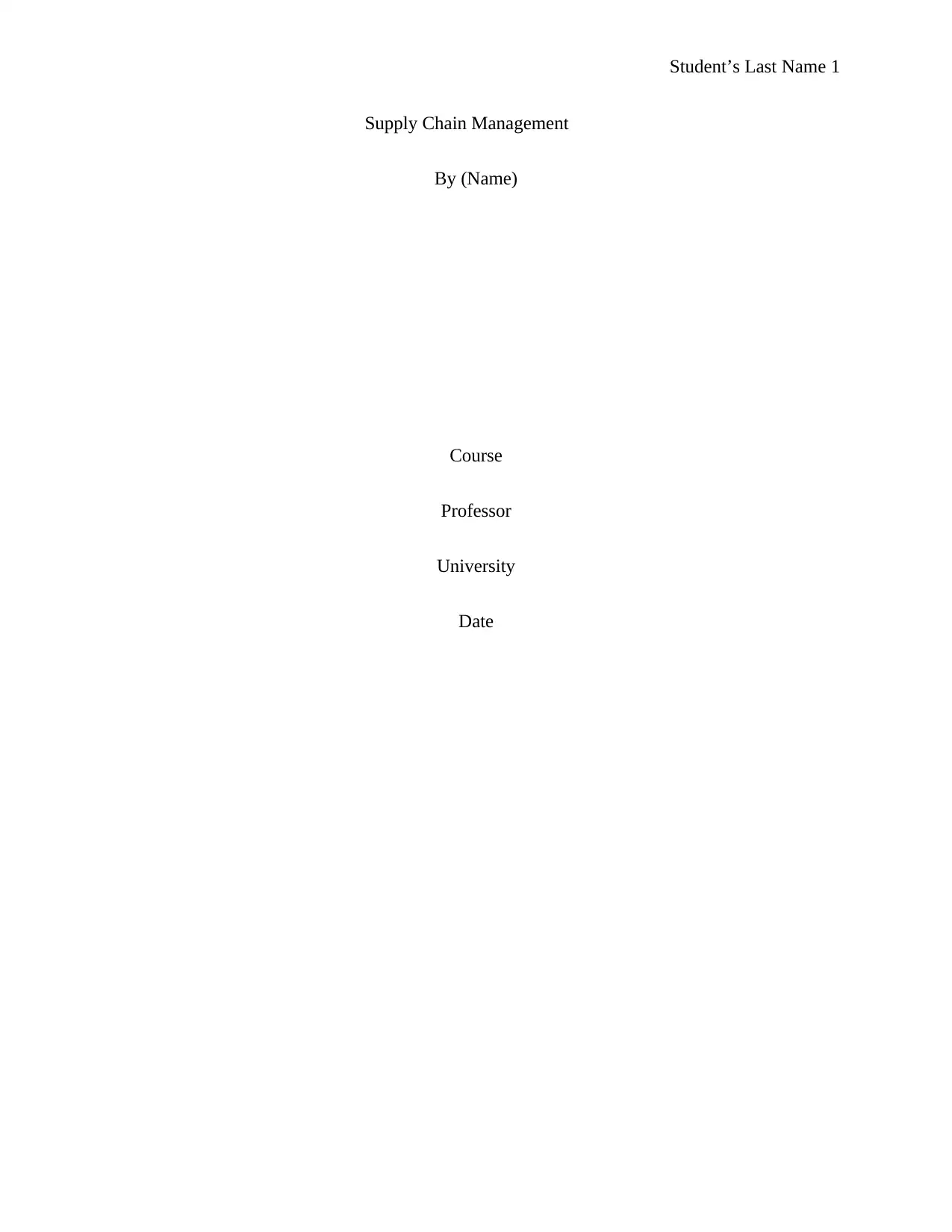
Student’s Last Name 1
Supply Chain Management
By (Name)
Course
Professor
University
Date
Supply Chain Management
By (Name)
Course
Professor
University
Date
Secure Best Marks with AI Grader
Need help grading? Try our AI Grader for instant feedback on your assignments.
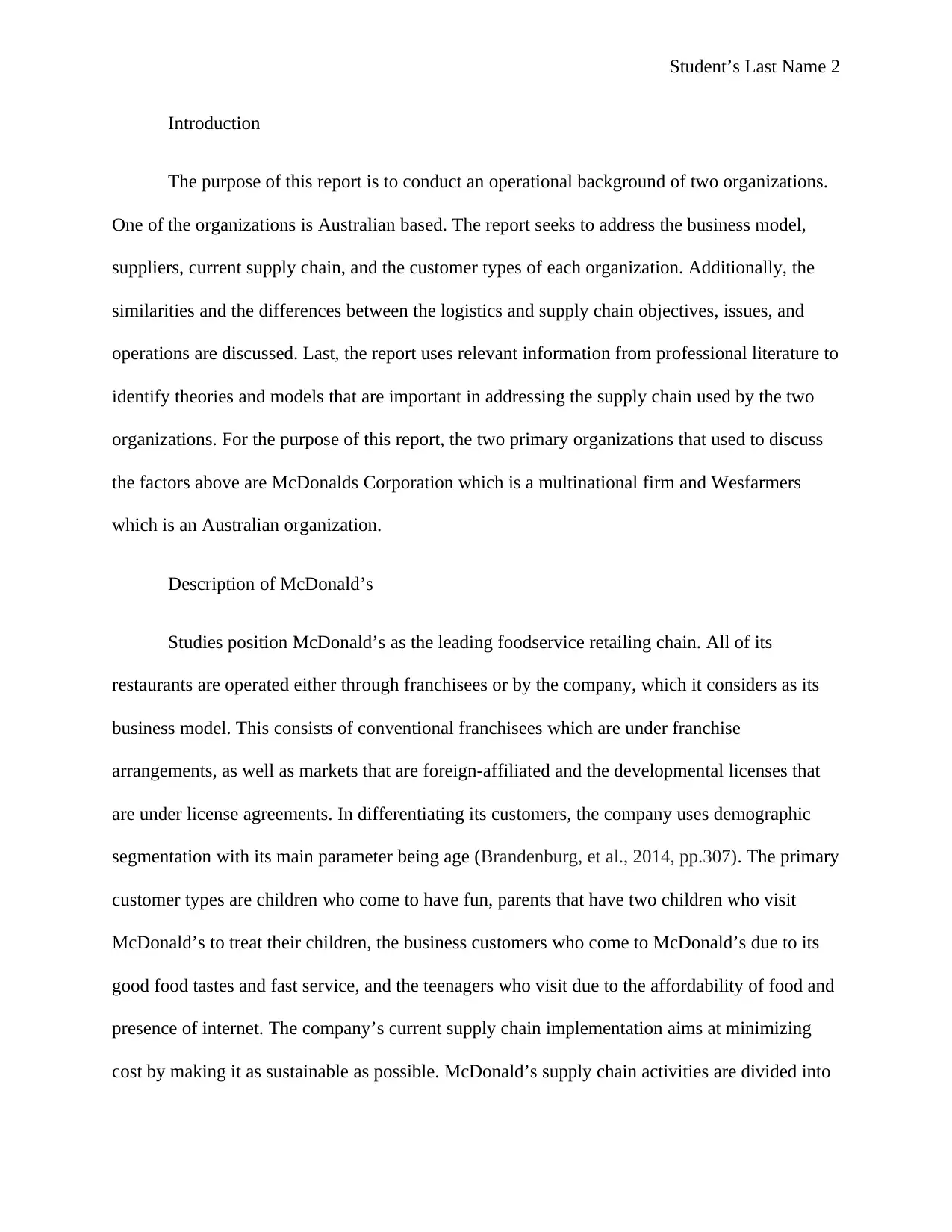
Student’s Last Name 2
Introduction
The purpose of this report is to conduct an operational background of two organizations.
One of the organizations is Australian based. The report seeks to address the business model,
suppliers, current supply chain, and the customer types of each organization. Additionally, the
similarities and the differences between the logistics and supply chain objectives, issues, and
operations are discussed. Last, the report uses relevant information from professional literature to
identify theories and models that are important in addressing the supply chain used by the two
organizations. For the purpose of this report, the two primary organizations that used to discuss
the factors above are McDonalds Corporation which is a multinational firm and Wesfarmers
which is an Australian organization.
Description of McDonald’s
Studies position McDonald’s as the leading foodservice retailing chain. All of its
restaurants are operated either through franchisees or by the company, which it considers as its
business model. This consists of conventional franchisees which are under franchise
arrangements, as well as markets that are foreign-affiliated and the developmental licenses that
are under license agreements. In differentiating its customers, the company uses demographic
segmentation with its main parameter being age (Brandenburg, et al., 2014, pp.307). The primary
customer types are children who come to have fun, parents that have two children who visit
McDonald’s to treat their children, the business customers who come to McDonald’s due to its
good food tastes and fast service, and the teenagers who visit due to the affordability of food and
presence of internet. The company’s current supply chain implementation aims at minimizing
cost by making it as sustainable as possible. McDonald’s supply chain activities are divided into
Introduction
The purpose of this report is to conduct an operational background of two organizations.
One of the organizations is Australian based. The report seeks to address the business model,
suppliers, current supply chain, and the customer types of each organization. Additionally, the
similarities and the differences between the logistics and supply chain objectives, issues, and
operations are discussed. Last, the report uses relevant information from professional literature to
identify theories and models that are important in addressing the supply chain used by the two
organizations. For the purpose of this report, the two primary organizations that used to discuss
the factors above are McDonalds Corporation which is a multinational firm and Wesfarmers
which is an Australian organization.
Description of McDonald’s
Studies position McDonald’s as the leading foodservice retailing chain. All of its
restaurants are operated either through franchisees or by the company, which it considers as its
business model. This consists of conventional franchisees which are under franchise
arrangements, as well as markets that are foreign-affiliated and the developmental licenses that
are under license agreements. In differentiating its customers, the company uses demographic
segmentation with its main parameter being age (Brandenburg, et al., 2014, pp.307). The primary
customer types are children who come to have fun, parents that have two children who visit
McDonald’s to treat their children, the business customers who come to McDonald’s due to its
good food tastes and fast service, and the teenagers who visit due to the affordability of food and
presence of internet. The company’s current supply chain implementation aims at minimizing
cost by making it as sustainable as possible. McDonald’s supply chain activities are divided into
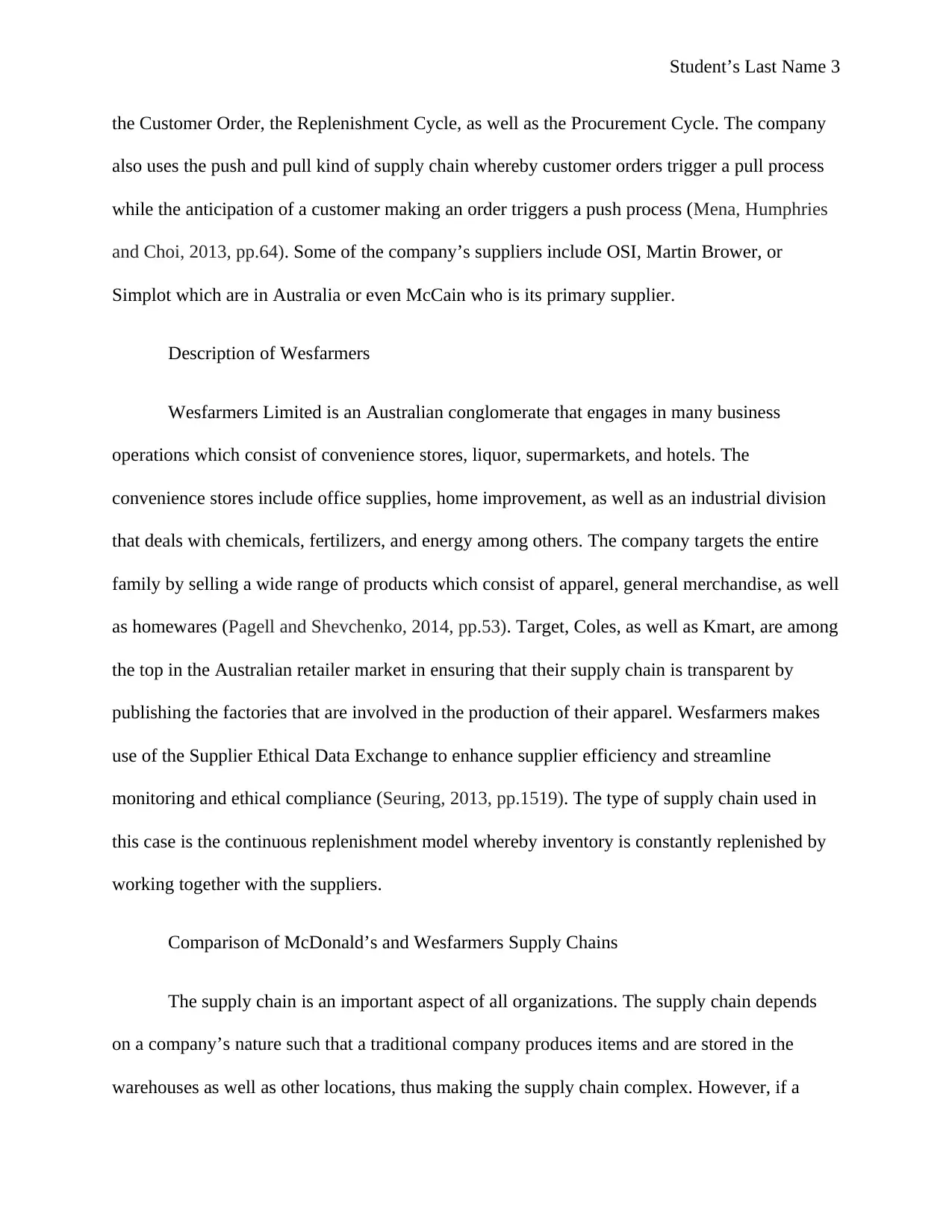
Student’s Last Name 3
the Customer Order, the Replenishment Cycle, as well as the Procurement Cycle. The company
also uses the push and pull kind of supply chain whereby customer orders trigger a pull process
while the anticipation of a customer making an order triggers a push process (Mena, Humphries
and Choi, 2013, pp.64). Some of the company’s suppliers include OSI, Martin Brower, or
Simplot which are in Australia or even McCain who is its primary supplier.
Description of Wesfarmers
Wesfarmers Limited is an Australian conglomerate that engages in many business
operations which consist of convenience stores, liquor, supermarkets, and hotels. The
convenience stores include office supplies, home improvement, as well as an industrial division
that deals with chemicals, fertilizers, and energy among others. The company targets the entire
family by selling a wide range of products which consist of apparel, general merchandise, as well
as homewares (Pagell and Shevchenko, 2014, pp.53). Target, Coles, as well as Kmart, are among
the top in the Australian retailer market in ensuring that their supply chain is transparent by
publishing the factories that are involved in the production of their apparel. Wesfarmers makes
use of the Supplier Ethical Data Exchange to enhance supplier efficiency and streamline
monitoring and ethical compliance (Seuring, 2013, pp.1519). The type of supply chain used in
this case is the continuous replenishment model whereby inventory is constantly replenished by
working together with the suppliers.
Comparison of McDonald’s and Wesfarmers Supply Chains
The supply chain is an important aspect of all organizations. The supply chain depends
on a company’s nature such that a traditional company produces items and are stored in the
warehouses as well as other locations, thus making the supply chain complex. However, if a
the Customer Order, the Replenishment Cycle, as well as the Procurement Cycle. The company
also uses the push and pull kind of supply chain whereby customer orders trigger a pull process
while the anticipation of a customer making an order triggers a push process (Mena, Humphries
and Choi, 2013, pp.64). Some of the company’s suppliers include OSI, Martin Brower, or
Simplot which are in Australia or even McCain who is its primary supplier.
Description of Wesfarmers
Wesfarmers Limited is an Australian conglomerate that engages in many business
operations which consist of convenience stores, liquor, supermarkets, and hotels. The
convenience stores include office supplies, home improvement, as well as an industrial division
that deals with chemicals, fertilizers, and energy among others. The company targets the entire
family by selling a wide range of products which consist of apparel, general merchandise, as well
as homewares (Pagell and Shevchenko, 2014, pp.53). Target, Coles, as well as Kmart, are among
the top in the Australian retailer market in ensuring that their supply chain is transparent by
publishing the factories that are involved in the production of their apparel. Wesfarmers makes
use of the Supplier Ethical Data Exchange to enhance supplier efficiency and streamline
monitoring and ethical compliance (Seuring, 2013, pp.1519). The type of supply chain used in
this case is the continuous replenishment model whereby inventory is constantly replenished by
working together with the suppliers.
Comparison of McDonald’s and Wesfarmers Supply Chains
The supply chain is an important aspect of all organizations. The supply chain depends
on a company’s nature such that a traditional company produces items and are stored in the
warehouses as well as other locations, thus making the supply chain complex. However, if a
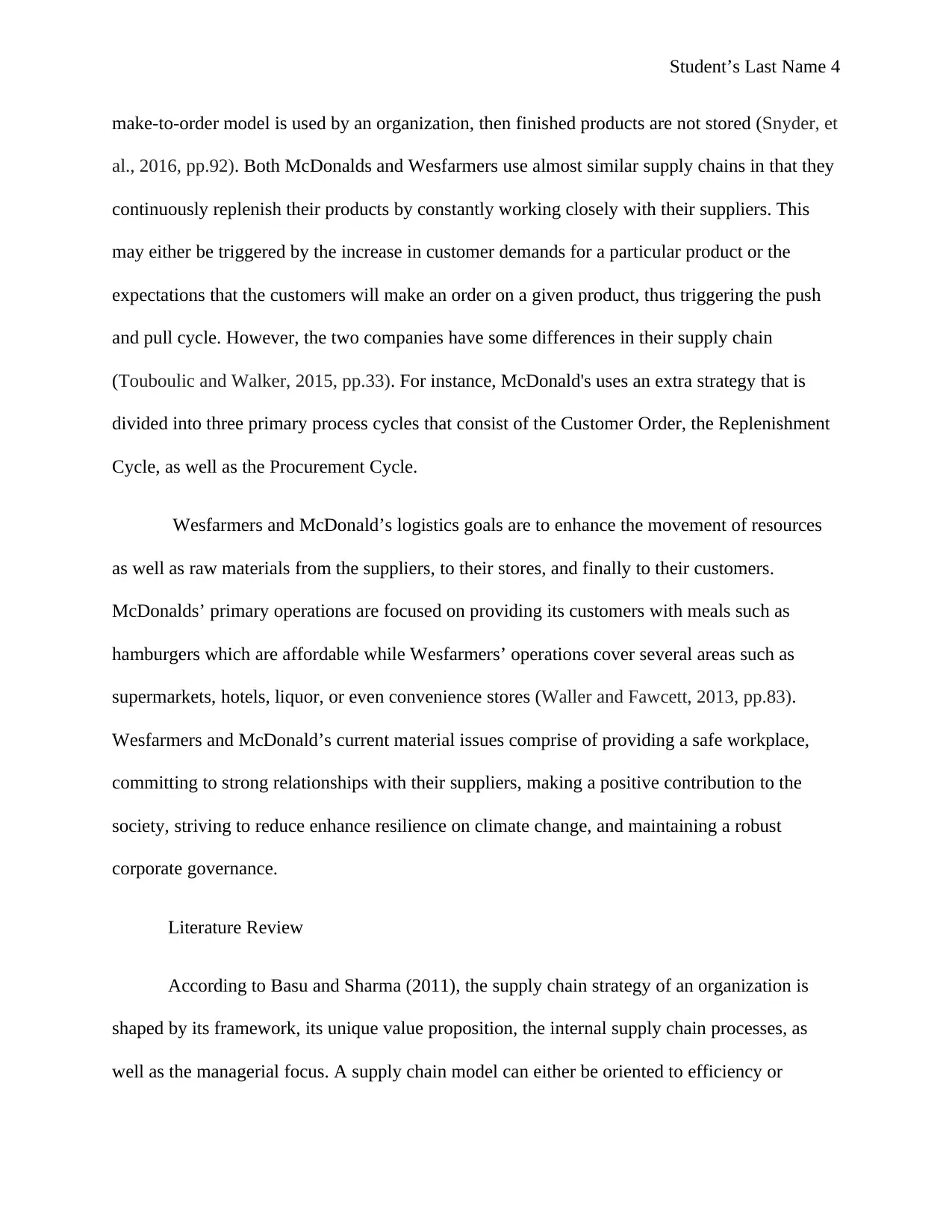
Student’s Last Name 4
make-to-order model is used by an organization, then finished products are not stored (Snyder, et
al., 2016, pp.92). Both McDonalds and Wesfarmers use almost similar supply chains in that they
continuously replenish their products by constantly working closely with their suppliers. This
may either be triggered by the increase in customer demands for a particular product or the
expectations that the customers will make an order on a given product, thus triggering the push
and pull cycle. However, the two companies have some differences in their supply chain
(Touboulic and Walker, 2015, pp.33). For instance, McDonald's uses an extra strategy that is
divided into three primary process cycles that consist of the Customer Order, the Replenishment
Cycle, as well as the Procurement Cycle.
Wesfarmers and McDonald’s logistics goals are to enhance the movement of resources
as well as raw materials from the suppliers, to their stores, and finally to their customers.
McDonalds’ primary operations are focused on providing its customers with meals such as
hamburgers which are affordable while Wesfarmers’ operations cover several areas such as
supermarkets, hotels, liquor, or even convenience stores (Waller and Fawcett, 2013, pp.83).
Wesfarmers and McDonald’s current material issues comprise of providing a safe workplace,
committing to strong relationships with their suppliers, making a positive contribution to the
society, striving to reduce enhance resilience on climate change, and maintaining a robust
corporate governance.
Literature Review
According to Basu and Sharma (2011), the supply chain strategy of an organization is
shaped by its framework, its unique value proposition, the internal supply chain processes, as
well as the managerial focus. A supply chain model can either be oriented to efficiency or
make-to-order model is used by an organization, then finished products are not stored (Snyder, et
al., 2016, pp.92). Both McDonalds and Wesfarmers use almost similar supply chains in that they
continuously replenish their products by constantly working closely with their suppliers. This
may either be triggered by the increase in customer demands for a particular product or the
expectations that the customers will make an order on a given product, thus triggering the push
and pull cycle. However, the two companies have some differences in their supply chain
(Touboulic and Walker, 2015, pp.33). For instance, McDonald's uses an extra strategy that is
divided into three primary process cycles that consist of the Customer Order, the Replenishment
Cycle, as well as the Procurement Cycle.
Wesfarmers and McDonald’s logistics goals are to enhance the movement of resources
as well as raw materials from the suppliers, to their stores, and finally to their customers.
McDonalds’ primary operations are focused on providing its customers with meals such as
hamburgers which are affordable while Wesfarmers’ operations cover several areas such as
supermarkets, hotels, liquor, or even convenience stores (Waller and Fawcett, 2013, pp.83).
Wesfarmers and McDonald’s current material issues comprise of providing a safe workplace,
committing to strong relationships with their suppliers, making a positive contribution to the
society, striving to reduce enhance resilience on climate change, and maintaining a robust
corporate governance.
Literature Review
According to Basu and Sharma (2011), the supply chain strategy of an organization is
shaped by its framework, its unique value proposition, the internal supply chain processes, as
well as the managerial focus. A supply chain model can either be oriented to efficiency or
Secure Best Marks with AI Grader
Need help grading? Try our AI Grader for instant feedback on your assignments.
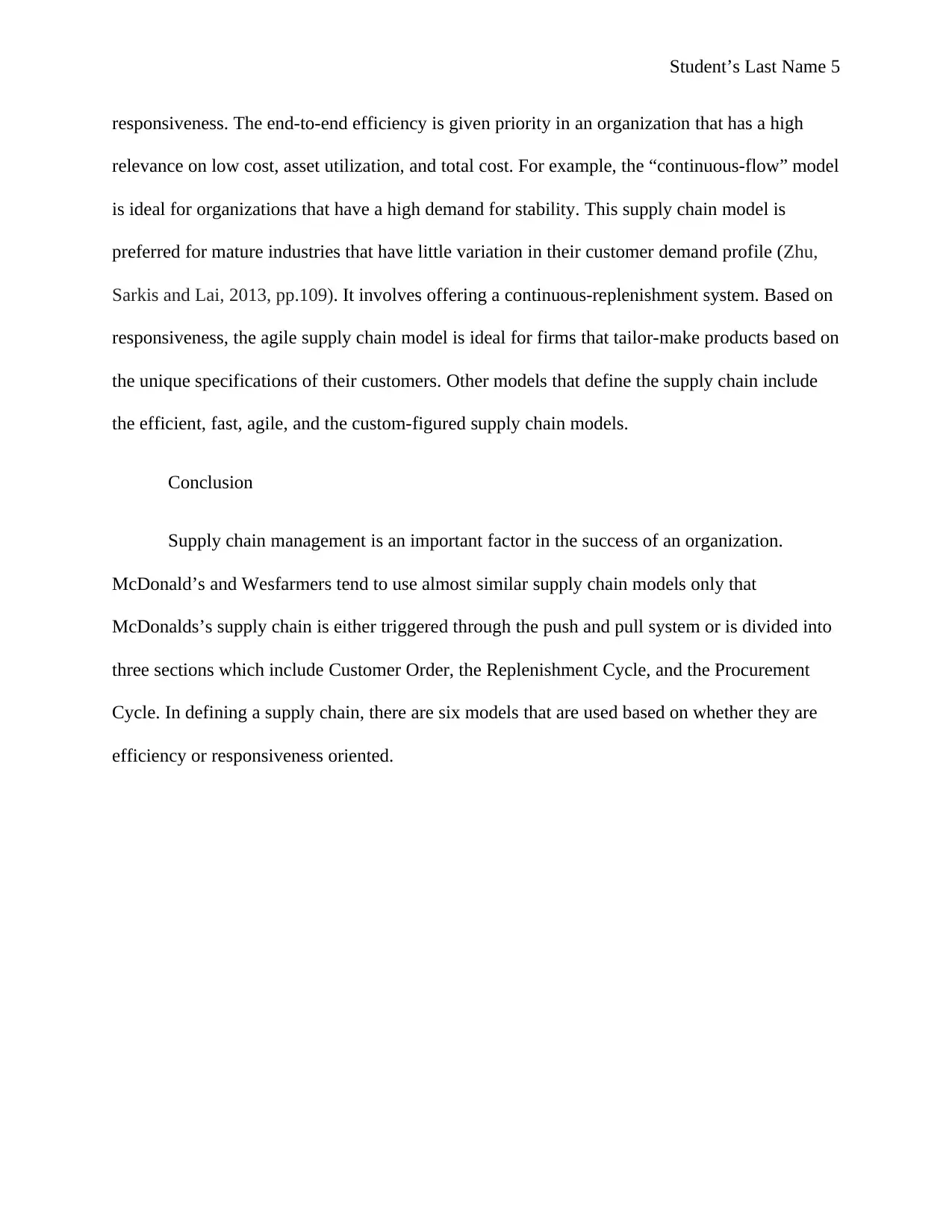
Student’s Last Name 5
responsiveness. The end-to-end efficiency is given priority in an organization that has a high
relevance on low cost, asset utilization, and total cost. For example, the “continuous-flow” model
is ideal for organizations that have a high demand for stability. This supply chain model is
preferred for mature industries that have little variation in their customer demand profile (Zhu,
Sarkis and Lai, 2013, pp.109). It involves offering a continuous-replenishment system. Based on
responsiveness, the agile supply chain model is ideal for firms that tailor-make products based on
the unique specifications of their customers. Other models that define the supply chain include
the efficient, fast, agile, and the custom-figured supply chain models.
Conclusion
Supply chain management is an important factor in the success of an organization.
McDonald’s and Wesfarmers tend to use almost similar supply chain models only that
McDonalds’s supply chain is either triggered through the push and pull system or is divided into
three sections which include Customer Order, the Replenishment Cycle, and the Procurement
Cycle. In defining a supply chain, there are six models that are used based on whether they are
efficiency or responsiveness oriented.
responsiveness. The end-to-end efficiency is given priority in an organization that has a high
relevance on low cost, asset utilization, and total cost. For example, the “continuous-flow” model
is ideal for organizations that have a high demand for stability. This supply chain model is
preferred for mature industries that have little variation in their customer demand profile (Zhu,
Sarkis and Lai, 2013, pp.109). It involves offering a continuous-replenishment system. Based on
responsiveness, the agile supply chain model is ideal for firms that tailor-make products based on
the unique specifications of their customers. Other models that define the supply chain include
the efficient, fast, agile, and the custom-figured supply chain models.
Conclusion
Supply chain management is an important factor in the success of an organization.
McDonald’s and Wesfarmers tend to use almost similar supply chain models only that
McDonalds’s supply chain is either triggered through the push and pull system or is divided into
three sections which include Customer Order, the Replenishment Cycle, and the Procurement
Cycle. In defining a supply chain, there are six models that are used based on whether they are
efficiency or responsiveness oriented.
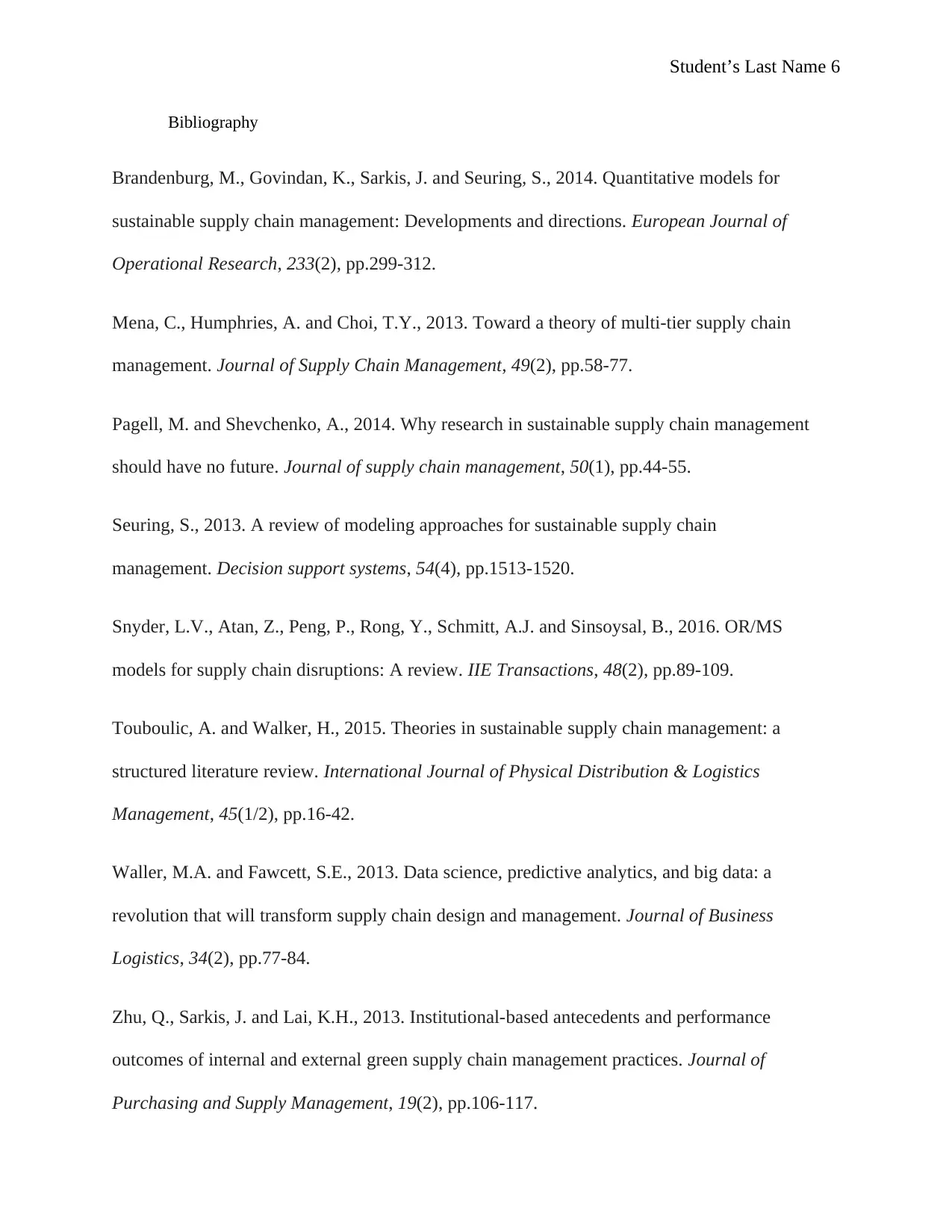
Student’s Last Name 6
Bibliography
Brandenburg, M., Govindan, K., Sarkis, J. and Seuring, S., 2014. Quantitative models for
sustainable supply chain management: Developments and directions. European Journal of
Operational Research, 233(2), pp.299-312.
Mena, C., Humphries, A. and Choi, T.Y., 2013. Toward a theory of multi‐tier supply chain
management. Journal of Supply Chain Management, 49(2), pp.58-77.
Pagell, M. and Shevchenko, A., 2014. Why research in sustainable supply chain management
should have no future. Journal of supply chain management, 50(1), pp.44-55.
Seuring, S., 2013. A review of modeling approaches for sustainable supply chain
management. Decision support systems, 54(4), pp.1513-1520.
Snyder, L.V., Atan, Z., Peng, P., Rong, Y., Schmitt, A.J. and Sinsoysal, B., 2016. OR/MS
models for supply chain disruptions: A review. IIE Transactions, 48(2), pp.89-109.
Touboulic, A. and Walker, H., 2015. Theories in sustainable supply chain management: a
structured literature review. International Journal of Physical Distribution & Logistics
Management, 45(1/2), pp.16-42.
Waller, M.A. and Fawcett, S.E., 2013. Data science, predictive analytics, and big data: a
revolution that will transform supply chain design and management. Journal of Business
Logistics, 34(2), pp.77-84.
Zhu, Q., Sarkis, J. and Lai, K.H., 2013. Institutional-based antecedents and performance
outcomes of internal and external green supply chain management practices. Journal of
Purchasing and Supply Management, 19(2), pp.106-117.
Bibliography
Brandenburg, M., Govindan, K., Sarkis, J. and Seuring, S., 2014. Quantitative models for
sustainable supply chain management: Developments and directions. European Journal of
Operational Research, 233(2), pp.299-312.
Mena, C., Humphries, A. and Choi, T.Y., 2013. Toward a theory of multi‐tier supply chain
management. Journal of Supply Chain Management, 49(2), pp.58-77.
Pagell, M. and Shevchenko, A., 2014. Why research in sustainable supply chain management
should have no future. Journal of supply chain management, 50(1), pp.44-55.
Seuring, S., 2013. A review of modeling approaches for sustainable supply chain
management. Decision support systems, 54(4), pp.1513-1520.
Snyder, L.V., Atan, Z., Peng, P., Rong, Y., Schmitt, A.J. and Sinsoysal, B., 2016. OR/MS
models for supply chain disruptions: A review. IIE Transactions, 48(2), pp.89-109.
Touboulic, A. and Walker, H., 2015. Theories in sustainable supply chain management: a
structured literature review. International Journal of Physical Distribution & Logistics
Management, 45(1/2), pp.16-42.
Waller, M.A. and Fawcett, S.E., 2013. Data science, predictive analytics, and big data: a
revolution that will transform supply chain design and management. Journal of Business
Logistics, 34(2), pp.77-84.
Zhu, Q., Sarkis, J. and Lai, K.H., 2013. Institutional-based antecedents and performance
outcomes of internal and external green supply chain management practices. Journal of
Purchasing and Supply Management, 19(2), pp.106-117.
1 out of 6
Related Documents
Your All-in-One AI-Powered Toolkit for Academic Success.
+13062052269
info@desklib.com
Available 24*7 on WhatsApp / Email
![[object Object]](/_next/static/media/star-bottom.7253800d.svg)
Unlock your academic potential
© 2024 | Zucol Services PVT LTD | All rights reserved.




